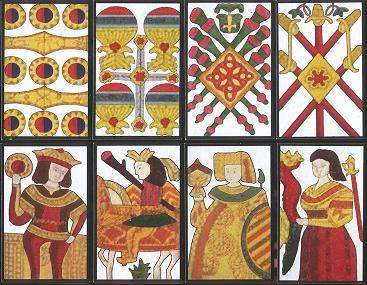
Tenshô Karuta: four pip cards (top row)
and four courts (a king, a cavalier and two knaves) |
The first pattern ever produced in the country is now referred to as Tenshô Karuta, after the Tenshô period (1573-1591). In those days, though, not this name, but the generic word karuta ("cards") was used. The design was clearly based on the early Portuguese decks, from which it had been copied. Its suits were Ôru (from the Portuguese suit of Ouros, i.e. "coins"), Koppu (from Copas, "cups"), Pau (from Paus, "batons") and Isu (short for Espadas, "swords").
Also the number of cards, forty-eight, was the same as in any deck from Portugal or Spain: each suit had pip cards from 1 to 9, and three courts named sôta (knave), kaba (cavalier) and rei (king), Japanized equivalents of the Portuguese names sota, cavaleiro and rei. |
The pips in the suit of Ôru (Coins) had the central part coloured in red and black. As during the following centuries the design of the Japanese cards grew more and more stylized, this apparently minor detail became the main visual link between the Ôru pips found in the several
Mekuri patterns, i.e. red and black circles or ovals, and these early cards (as shown below).
In the Tenshô Karuta the pips of Isu (Swords) were coloured in red; this may be a little surprising, because according to the modern shape of Latin suits, Swords are always blue; but in early Hispanic editions they often had more than one colour, including red. Also this feature was maintained by Mekuri patterns, in which the Isu pips are extremely stylized, and look like stripes, but are still red. |

7 of Ôru from the Tenshô Karuta (left),
and the same subject from two Mekuri patterns |

il seme di Koppu giapponese, e il
suo equivalente ispanico-portoghese |
The Hau (Batons) were correctly interpreted as cudgels, but in the Japanese version they had red notches along the shaft, making them vaguely reminiscent of a bamboo stem.
The Koppu (Cups) underwent a certain change; probably their shape was partly misunderstood by the Japanese cardmakers, as the uppermost red section no longer represented the inside part of the goblet, as it did - and still does - in Hispanic patterns. |
The arrangement of the the pips in the suits of Isu and Hau, that form many intersections at regular intervals, covered by diamond-shaped decorations, was also found in the old Portuguese pattern, as well as the female knaves, one more typical feature; in the
Tenshô Karuta the knaves of Coins and Cups wear a veil, while the other two apparently hold a long unidentified object, only a part of which is visible due to the clipped illustrations, as will be said further on.
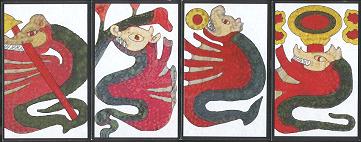
the Tenshô Karuta aces |
But the subjects that most of all reveal the origin of the design are the dragons on the four aces, the real hallmark of the Portuguese pattern; still clearly recognizable in the Tenshô cards, in time they became more and more stylized, up to the point that in Mekuri patterns their shape turned completely abstract, although they are still there. |
What differed most between the European cards and the newborn
Tenshô Karuta was their size: the Japanese ones were definitely smaller, more or less as a modern patience deck.
The Portuguese sailors had probably trimmed their cards, maybe even more than once, so that a few details next to the rim were actually clipped off. The difference is particularly evident in some of the subjects, such as the cavaliers, in which the horse's heads are no longer visible, as if they had been cut off.
But why had the deck been "shrinked"? This may be explained with the ancient use of trimming cards on their edges when the latter got damaged or worn (a reconstruction showing what size a full card might have had is shown on the left). It is likely that the Portuguese sailors used this expedient during their voyages, also because in foreign lands the cards they normally used, i.e. either the Portuguese or the Spanish pattern, were not available.
|
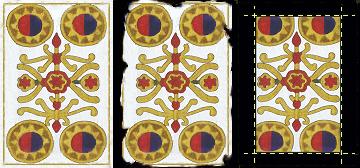
had the Portuguese cards not been trimmed, Japanese decks
might have been larger, similar in size to European ones |
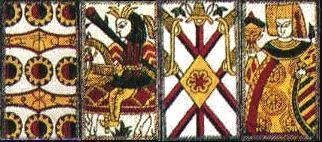
some of the same subjects previously shown,
from the reproduction in the Miike Museum, Ômuta |
The Japanese likely copied these cards as they saw them for the first time, i.e. maintaining the clipped images, which they believed to be the actual design. This also explains their small size, compared to any Western deck. Smaller cards might have also been easier to handle by Japanese players; but the reduction was probably not a deliberate initiative of the local card makers, as maintained by some scholars, but simply a coincidence due to the trimmed Portuguese decks. |
Of the number of decks manufactured in the 16th century, only a single card has survived, a king of Ôru kept in the Miike Museum, in Ômuta (southern Japan), not far from Kagoshima, where the first portuguese ships entered the country. The picture on the left shows both its sides.
However, among the exhibits held by the Kobe City Museum is a wooden box that was made by cutting into fragments the original wood-blocks of a whole Tenshô Karuta set: thanks to this box it has been possible to find out exactly what the lost cards looked like (obviously, only the ones specifically belonging to this deck).
The "EXHIBITION"
page of the Miike Museum features the whole set of 48 reproduced subjects. |

the only original surviving card:
the king of Ôru, front and back
(courtesy of Tadahiko Norieda) |
In 1633, due to a very conservative nationalist policy, the use of foreign cards, as well as
any other Western-related activity, was forbidden. Anybody caught playing with Western cards
would have been branded as a follower of Christanity (which was proscribed, as well), and eventually
sentenced to death. Therefore, attempts were made to produce local patterns to by-pass the ban.
Nevertheless, it should be mentioned that the ancient matching games had survived, and
a 17th century source mentions cards for
E-Awase (literally "picture matching"),
clearly inspired by the early games played with shells.

UNSUN KARUTA
the cards shown are from an edition reissued by Ôishi (Japan)
Another local deck was created in the second half of the 17th century,
called Unsun Karuta after the name of two special
court cards (see below). It was strongly inspired by the original Portoguese card scheme,
basically repeating the Tenshô Karuta, yet introducing a new suit, more court cards and
joker cards too. |
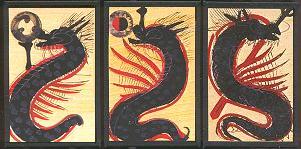
dragons from the suits of Guru, Ôru and Isu |
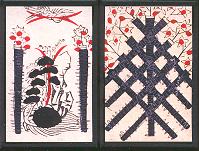
Unsun Karuta: 2 and 9 of Hau |
The Unsun Karuta deck is made of seventy-five cards, divided into
five suits, four of which were borrowed directly from the Portoguese ones; the suit of Hau
or Pau (Batons) features sticks from which wigs, leaves and flowers (or berries) spring,
similar to the ones most patterns of Hispanic origin still now have: for this reason this
suit is also known as Hana ("Flowers"). And in both the suits of Hau and Isu (Batons and Swords), the respective
pips cross each other in a fashion typical of the early Portuguese pattern. |
The fifth suit, instead, is non-standard; it is called Guru ("round, around"), and it features comma-shaped strokes arranged in a circular pattern, almost forming a whirl.
Each of the five suits had more cards than a Tenshô deck: fifteen, versus the usual twelve, due to
the greater number of courts, which are a cavalier, a seated king, a queen, plus
two further personages called Sun and Un and a dragon.
The queen is the card into which the original knave was turned, as testified by the
Portuguese-derived name of the latter, sôta, which remained unchanged for the
female personage, yet given a higher ranking. The dragons, instead, which in the Portuguese decks were only the aces' decorations,
in the Unsun Karuta were turned into individual subjects, so that
in each suit both a dragon and an ace are found.
The scheme of the deck is summarized in the following table. |

1 (ace) of Guru |
| | SUITS | | |
Ôru · Oru
(Coins)
|
Koppu · Kotsu
(Cups)
|
Hau · Pau
(Batons)
|
Isu
(Swords)
|
Guru
(whirl pattern)
|
| PIP CARDS | 1 · 2 · 3 · 4 · 5 · 6 · 7 · 8 · 9 |
| COURT CARDS | Kaba (horse, cavalier) |
| (from lower to higher) | Rei (king) |
| Sôta (queen, from the Portuguese knave) |
| Sun (non-standard subject) |
| Un (non-standard subject) |
| Robai (dragon, as a court or as a joker) |
|
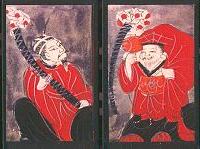
(top) Sun and Un of Hau;
(bottom) Sun and Un of Koppu
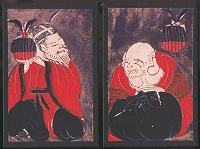
|
|
The two courts called Sun and Un have dark backgrounds, while
the remaining ones have them in yellow. The Sun cards depict Chinese personages, while the
Un cards feature four of the Seven Deities of Good Luck (or Lucky Gods), seated and
smiling personages borrowed from Buddhist mythology. The ones present in the Unsun Karuta
are shown on the right. Instead the Un of the suit of Guru features Dharma, the Indian priest
credited for having taken Zen Buddhism into China, in the 6th century.
|
|
| UN CARDS' DEITIES | SUIT |
| Ebisu (god of fishermen and good fortune) | Ôru |
| Hotei (god of contentment and happiness) | Koppu |
| Fukurokuji (god of wisdom and longevity) | Isu |
| Daikoku (god of farmers and wealth) | Hau |
| Dharma (Daruma) | Guru |
|
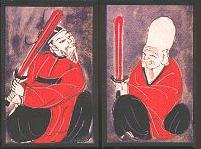
Sun and Un of Isu |

Kaba, Rei and Sôta of Guru |
Despite a fully Portuguese origin has always been claimed for the
Unsun Karuta, we should not forget that by those times, the only Westerners legally allowed
to run commercial trades in Japan were the Dutch; five-suited hunting decks (see the
main
Historical Notes page) were
indeed a variety of cards known in Germany and, very likely, in the Netherlands too.
Therefore, while this pattern is undoubtly similar to the
Tenshô Karuta, its
composition may have been partly inspired by more complex decks once used in Northern Europe.
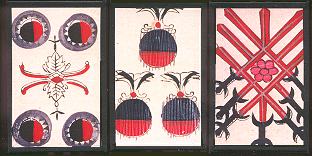
Unsun Karuta: 4 of Ôru, 3 of Koppu and 7 of Isu |
Furthermore, both Tenshô Karuta and Unsun Karuta patterns were used for playing
trick games, similar to those played in Europe with tarots and hunting decks. Such games
were more complicated than the "ordinary" gambling ones, likely played by the common
people with the standard Portuguese and Spanish decks. |
Another interesting detail is the historically early
presence of a female court among the subjects of the Unsun Karuta.
Portuguese cards had no queens, although their knaves
were female. However, we cannot exclude a contamination by the tarot, the only
early deck with four courts (or sometimes more), still very popular in the 17th century
Europe, in which both a knave and a queen were present. This may also be suggested by the
fact that in the game called "8-Player Meri", the four dragons act as jokers (i.e. as the
tarot's Fool), while a joker card was not present in the Portuguese deck. |
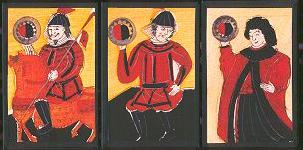
Kaba, Rei and Sôta of Ôru |
At present, Unsun Karuta may be considered an extinct game, despite a few members
of societies which study traditional pastimes still keep it alive.